Understanding the Importance of Early Cardiology Evaluation
Heart disease remains the leading cause of death globally, yet many individuals overlook early signs that could signal serious problems. Recognizing when to consult a cardiologist can be life-saving. This article explores seven critical signs that suggest you need a cardiology evaluation, helping you stay informed and proactive in managing your heart health.
Heart Health Key Facts
- Severe or radiating chest pain, especially with symptoms like shortness of breath or nausea, warrants emergency medical care.
- Unexplained shortness of breath and fatigue may indicate underlying conditions such as heart failure or coronary artery disease.
- Irregular heartbeats or palpitations can be signs of arrhythmias, requiring evaluation to prevent stroke and other complications.
- Persistent legs or ankle swelling can signal heart failure, necessitating assessment by a cardiologist.
- High blood pressure often has no symptoms but causes significant damage; regular check-ups and management are vital.
- Family history of early-onset heart disease increases your risk, advocating for earlier screening and possible genetic testing.
- Leg pain or cramps during activity suggest peripheral arterial disease, which indicates systemic atherosclerosis impacting heart health.
- Common signs of heart disease include chest pain, shortness of breath, irregular heartbeat, swelling, and unexplained fatigue.
- Urgent symptoms like intense chest pain, fainting, or severe shortness of breath necessitate calling emergency services immediately.
- Early detection through comprehensive evaluation, including physical exams and diagnostic tests, improves management and prevents severe complications.
1. Persistent or Severe Chest Pain
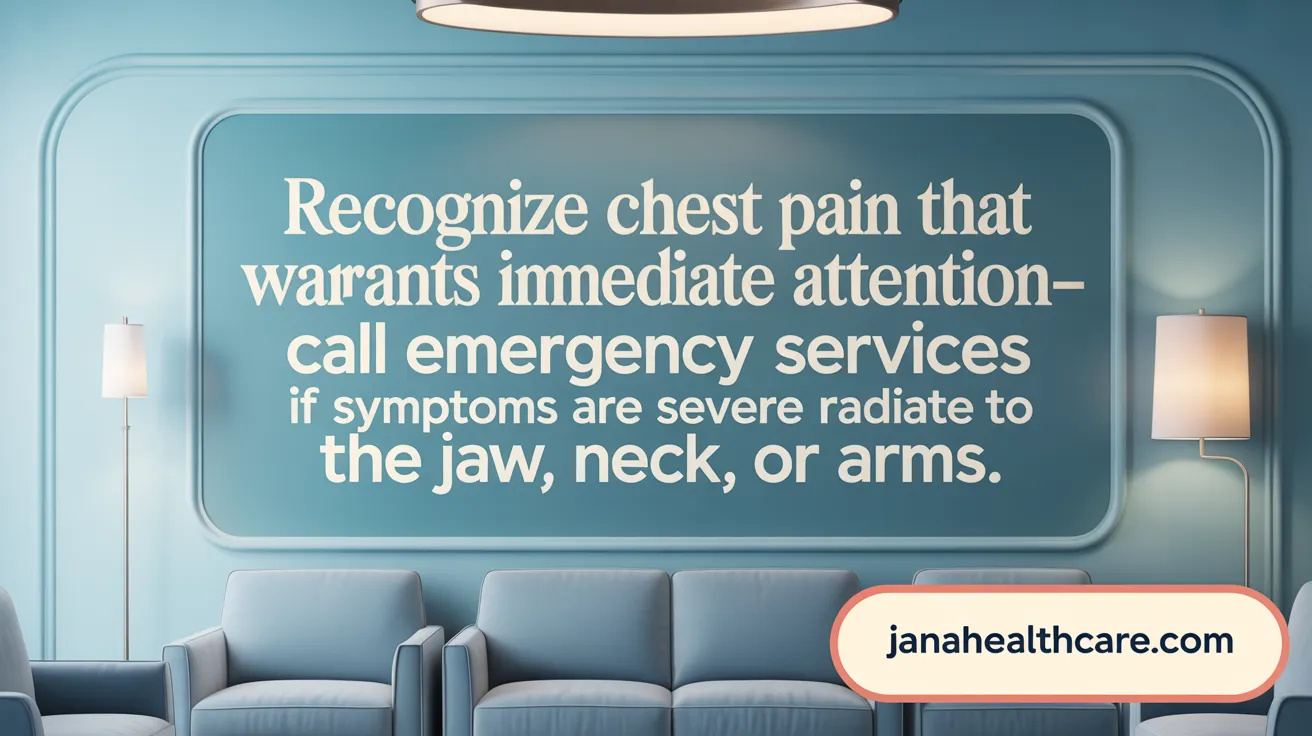
What signs and symptoms indicate that I should see a cardiologist?
Persistent or intense chest pain is one of the primary reasons to consult a cardiologist. When chest discomfort feels like pressure, squeezing, or heaviness, especially if it worsens with activity or persists even at rest, it may signify underlying heart problems such as angina or a potential heart attack. These symptoms are critical indicators that require prompt medical evaluation to prevent serious complications. For more information, see Chest pain and coronary artery disease and Chest pain and heart evaluation.
What are the warning signs of heart problems that require immediate medical attention?
If chest pain radiates to your jaw, neck, arms, or back, it is a clear sign of a possible heart attack. Accompanying symptoms like shortness of breath, sweating, nausea, dizziness, or a feeling of impending doom further increase the urgency. Anyone experiencing these signs should seek emergency medical care immediately, as quick intervention can save lives.
Understanding these warning signs is vital. Early recognition and swift response can significantly reduce heart damage and improve outcomes. If you notice persistent or severe chest pain, do not delay—call emergency services or visit the nearest hospital. For more on Warning signs of heart disease and When to call 911 for a heart attack visit these resources.
For further details on when chest pain warrants evaluation, searching with the phrase "Chest pain indications for cardiology evaluation" can provide additional medical guidance and resources.
2. Shortness of Breath and Unexplained Fatigue
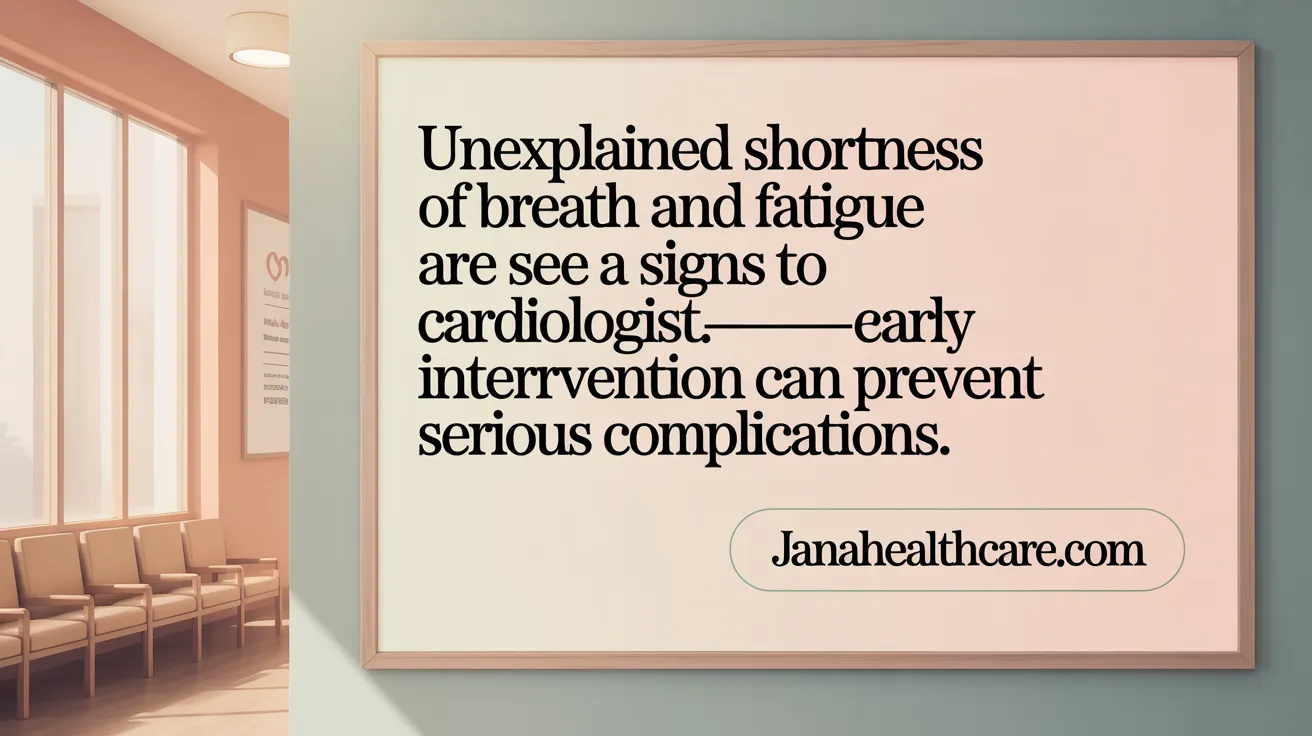
What signs and symptoms indicate that I should see a cardiologist?
Unexplained shortness of breath and fatigue are important symptoms that should not be ignored. These signals may suggest underlying heart conditions such as congestive heart failure or coronary artery disease. Learn more about Signs it's time to see a cardiologist.
When the heart's pumping ability is compromised, blood can back up into the lungs, causing difficulty breathing during activity or even at rest. Persistent fatigue, especially when it is sudden or severe, can also indicate that the heart is not effectively circulating blood, which may affect organ function. See more about Shortness of breath in heart failure.
These symptoms are primary reasons to seek a consultation with a cardiologist. Early evaluation can lead to diagnosis and management, helping prevent further deterioration or serious events like a heart attack or heart failure. For details on Symptoms requiring cardiologist consultation.
In summary, any unexplained shortness of breath coupled with ongoing fatigue is a warning sign that your heart health needs professional assessment. Timely check-ups can ensure appropriate treatment and improve quality of life. More on When to see a cardiologist.
For more detailed information, search for "Shortness of breath and fatigue heart disease".
3. Irregular Heartbeats and Palpitations
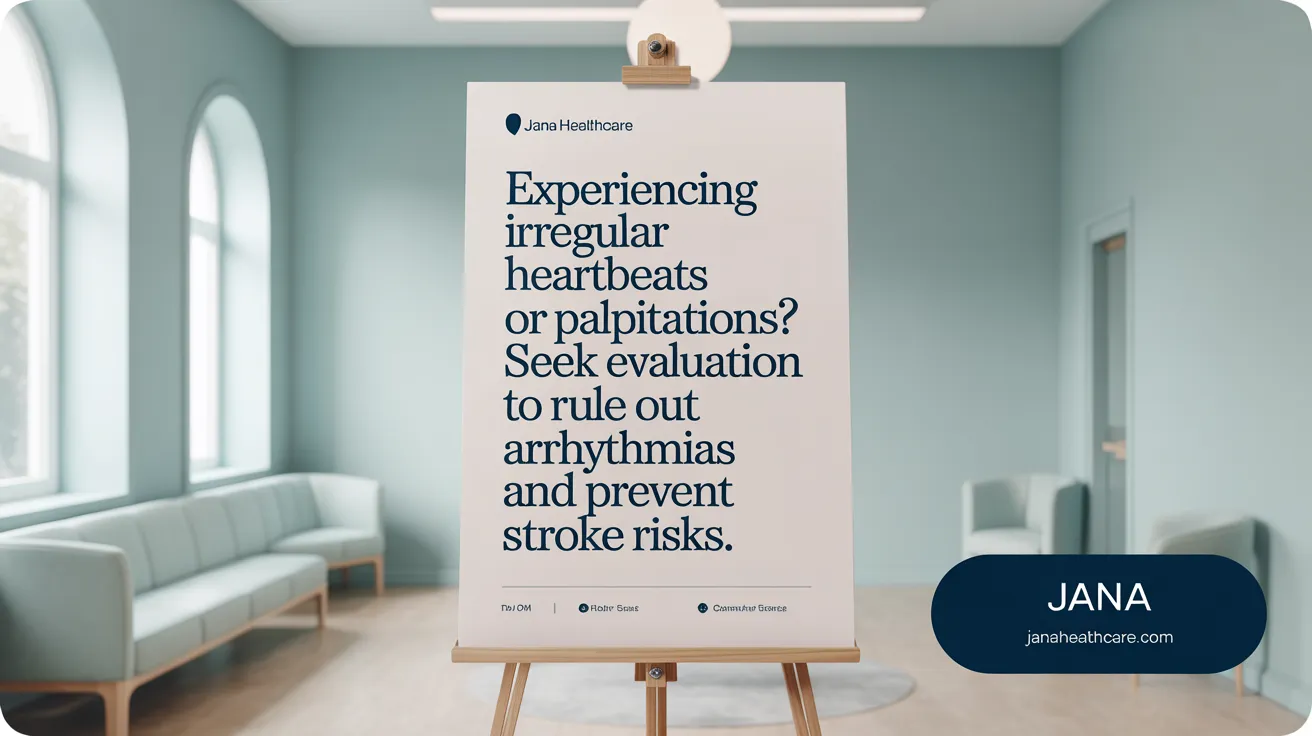 Palpitations, or the sensation of a racing, fluttering, or skipped heartbeat, serve as important signals that warrant medical attention. Such irregular heart rhythms can be a warning sign of arrhythmias, including atrial fibrillation, which is a common but potentially serious condition.
Palpitations, or the sensation of a racing, fluttering, or skipped heartbeat, serve as important signals that warrant medical attention. Such irregular heart rhythms can be a warning sign of arrhythmias, including atrial fibrillation, which is a common but potentially serious condition.
These abnormal heart rhythms can cause symptoms like chest discomfort, dizziness, fainting, or shortness of breath. In some cases, palpitations occur sporadically, but persistent or frequent episodes should prompt a consultation with a cardiologist. Diagnosing the underlying cause is essential because arrhythmias may increase the risk of stroke or other heart complications if left untreated.
If you experience irregular heartbeats alongside other symptoms such as dizziness or chest pain, it’s crucial to seek specialized care promptly. A cardiologist can perform diagnostic tests like EKGs, Holter monitors, or event recorders to track your heart’s electrical activity and determine whether treatment is needed.
4. Swelling in the Legs, Ankles, or Feet
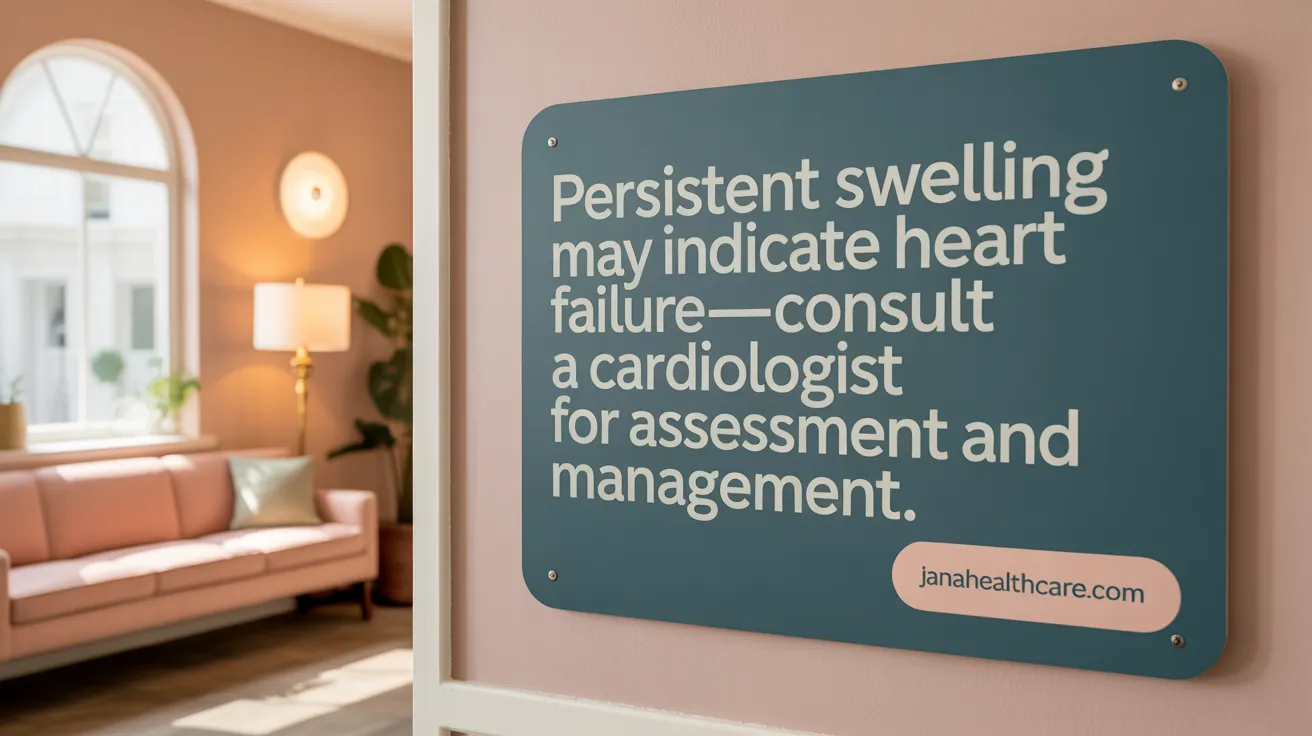 Swelling in the legs, ankles, or feet is a common sign that may indicate heart failure or other issues related to poor heart function. When the heart is unable to pump blood effectively, blood can back up into the veins, leading to fluid accumulation in the lower extremities. This condition, known as edema, results in visible swelling that often worsens with prolonged standing or at the end of the day.
Swelling in the legs, ankles, or feet is a common sign that may indicate heart failure or other issues related to poor heart function. When the heart is unable to pump blood effectively, blood can back up into the veins, leading to fluid accumulation in the lower extremities. This condition, known as edema, results in visible swelling that often worsens with prolonged standing or at the end of the day.
Fluid retention caused by heart problems can also lead to symptoms such as tightness or heaviness in the affected limbs. Recognizing this swelling early is crucial because it reflects possible underlying cardiovascular issues, including heart failure. If left unaddressed, the condition can worsen, leading to more severe complications.
It's important to seek medical evaluation if you notice persistent or worsening swelling in your legs, ankles, or feet. A cardiologist can assess your heart health through physical examination and diagnostic tests to determine if your swelling is related to cardiac function. Early diagnosis and management can help prevent further heart deterioration and improve overall health.
What signs and symptoms indicate that I should see a cardiologist? Swelling in legs, ankles, or feet, especially persistent or worsening, can signal heart failure and necessitates prompt cardiology assessment.
5. High Blood Pressure and Its Implications
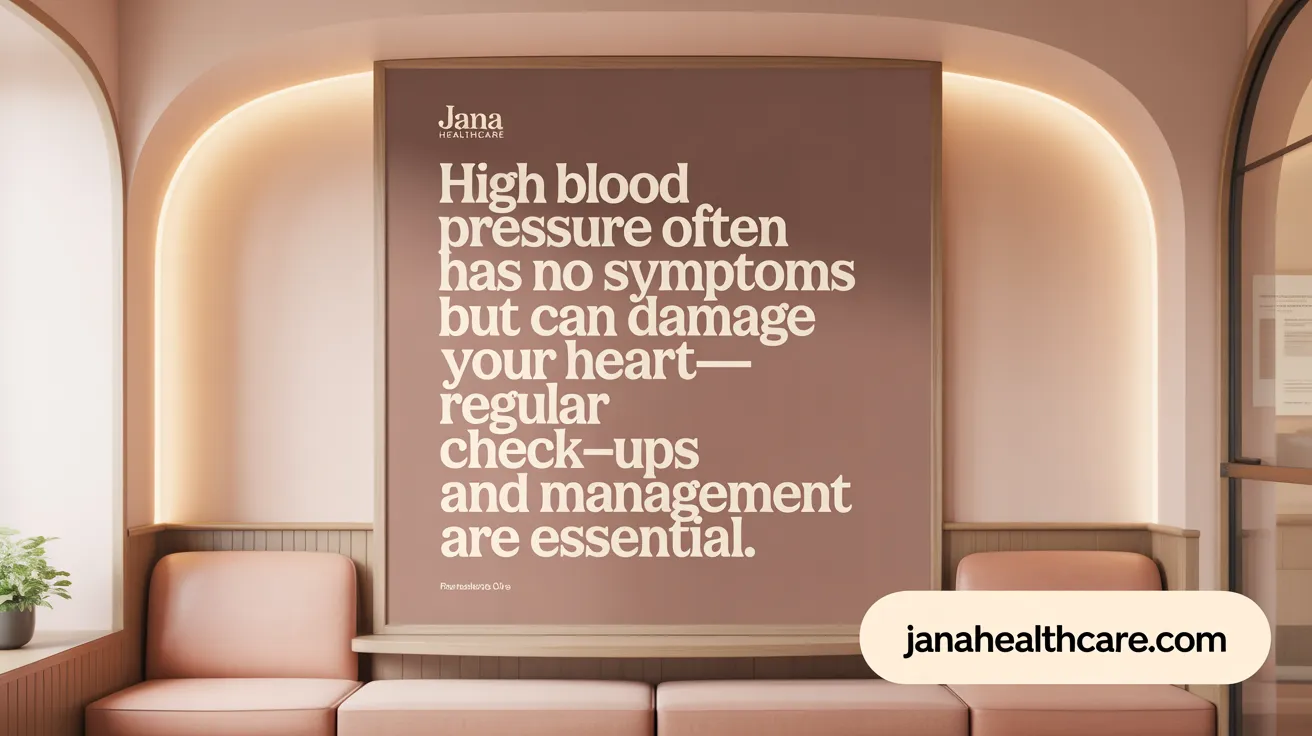
What signs and symptoms indicate that I should see a cardiologist?
Persistent high blood pressure, or hypertension, is a major factor increasing the risk of heart disease. While it often has no symptoms, uncontrolled hypertension can damage your arteries, heart, kidneys, and brain. Learn more about High blood pressure risks.
Seeing a cardiologist is essential if blood pressure remains high despite medication, or if you experience symptoms like dizziness, chest discomfort, or irregular heartbeats. Regular monitoring and management by a cardiology specialist can help prevent serious complications such as strokes, heart attacks, and heart failure. Identifying Symptoms requiring cardiologist consultation is important.
High blood pressure puts extra strain on your heart and blood vessels, leading to thickening of the heart muscle and narrowing of the arteries. Over time, this damage can cause the heart to work harder and less efficiently. The Impact of uncontrolled hypertension elaborates on this.
Management by a cardiologist includes:
- Regular blood pressure monitoring
- Personalized medication plans
- Lifestyle advice, such as diet and exercise
- Advanced testing to assess heart and artery health
Read about Cardiology consultation overview and Comprehensive cardiovascular assessment for these management strategies.
Consulting a cardiologist early helps control hypertension effectively, reducing the risk of life-threatening events and preserving heart health. For detailed signs and reasons to see a cardiologist, see Signs it's time to see a cardiologist and When to see a cardiologist.
More about hypertension risk and management
For those seeking further information, searching for "Hypertension risk cardiology evaluation" can provide insights into comprehensive assessment and treatment options. Additionally, learn about Managing high blood pressure and High blood pressure and heart health for more information.
6. Family History and Genetic Risks
A family history of early-onset heart disease plays a crucial role in your personal risk of developing heart problems. If a parent, sibling, or close relative experienced a heart attack or developed coronary artery disease before age 50 (for men) or age 60 (for women), your chances of encountering similar issues are higher (Family history of heart disease).
Genetically, some conditions like familial hypercholesterolemia (FH) lead to extremely high cholesterol levels from a young age, increasing early heart attack risk (Familial hypercholesterolemia and inherited cholesterol disorders). Inherited factors can also influence the likelihood of conditions such as arrhythmias, congenital heart defects, and certain cardiomyopathies (Inherited heart disease concerns).
When family history indicates a higher risk, it’s advisable to consult a cardiologist for targeted screening. This may include advanced blood tests, genetic testing, and imaging like coronary calcium scans to assess your specific risk profile (Cardiology consultation overview, Coronary artery calcium scans).
A family history that suggests genetic predisposition warrants particular attention to early detection strategies. This proactive approach can lead to lifestyle modifications and medical interventions that significantly reduce the chance of severe heart events (Signs it's time to see a cardiologist). Recognizing these risks early allows for personalized prevention plans tailored to your genetic makeup (Preventive Cardiology and Risk Management).
What signs and symptoms indicate that I should see a cardiologist? A family history of early heart disease significantly raises risk and is a strong indication to seek cardiology screening and preventive care (Ten signs it’s time to see a cardiologist).
For more information, searching
7. Leg Pain and Peripheral Arterial Disease
What signs and symptoms indicate that I should see a cardiologist?
Leg pain, cramps, or numbness during walking or activity often point to peripheral arterial disease (PAD). PAD occurs when arteries in the legs become narrowed or blocked due to atherosclerosis, the same process affecting coronary arteries.
This condition signals a higher likelihood of broader cardiovascular issues, including heart disease. Because PAD and coronary artery disease share similar risk factors—like high blood pressure, high cholesterol, diabetes, and smoking—assessment by a cardiologist is essential.
A detailed vascular and cardiac evaluation can identify the extent of arterial damage and guide appropriate treatment to prevent more serious events such as heart attacks or strokes.
Why is assessment by a cardiologist important for vascular and heart health?
A cardiologist specializes in diagnosing and managing both heart and vascular conditions. When symptoms like leg pain occur, it’s not just a sign of local arterial problems but an indication of systemic atherosclerosis.
Early evaluation through tests such as ultrasound imaging of blood vessels and stress tests allows doctors to determine the severity of the disease and implement lifestyle changes, medications, or interventions to improve overall cardiovascular health.
By addressing PAD early, patients reduce the risk of future cardiac events and improve circulation, mobility, and quality of life.
| Sign/Symptom | Associated Condition | Recommended Action | Additional Note |
|---|---|---|---|
| Pain or cramps in legs | Peripheral arterial disease (PAD) | Consult a cardiologist for vascular assessment | Many factors can contribute, including smoking and diabetes |
| Numbness or coldness in extremities | Reduced blood flow | Vascular ultrasound and risk assessment | Indicates systemic arterial narrowing |
| Leg pain during walking | Intermittent claudication | Lifestyle modifications, medications, or procedures | Improve circulation and reduce systemic risk |
Always recognize that symptoms like leg pain are signals to evaluate your cardiovascular system comprehensively. Early assessment by a cardiologist can significantly impact long-term heart and vascular health.
What signs and symptoms indicate that I should see a cardiologist?
Overview of key symptoms indicating cardiology referral
Recognizing the signs that warrant seeing a cardiologist is crucial for early detection and treatment of heart conditions. Common indicators include chest pain or discomfort which may feel like pressure, squeezing, or heaviness, especially if it radiates to the shoulders, neck, jaw, or back. Persistent shortness of breath during activity or rest, unexplained fatigue, and swelling in the legs, ankles, or feet are also red flags. Irregular heartbeats or palpitations, fainting episodes, and dizziness are additional symptoms that suggest the heart may not be functioning properly (Signs you need a cardiologist).
Risk factors to watch for
Certain risk factors heighten the likelihood of developing heart disease and should prompt consultation with a cardiologist. These include high blood pressure, high cholesterol, diabetes, smoking history, family history of early heart disease, and peripheral arterial disease. Lifestyle factors such as obesity, sedentary habits, and stress also contribute (Heart disease risk factors). Being aware of these factors allows for timely assessment and management.
When symptoms warrant specialized assessment
If you experience symptoms like chest pain, especially if it worsens with exertion or occurs at rest, it could signal angina or a potential heart attack (Chest pain and coronary artery disease). Symptoms such as new or irregular palpitations, fainting, or unexplained dizziness require prompt evaluation. Swelling in your legs or sudden fatigue may also point to heart failure or other cardiovascular issues (Heart failure symptoms and signs). Early referral to a cardiologist allows for specialized testing—such as ECG, echocardiogram, or stress tests—and tailored treatment plans to improve heart health. Don't delay seeking help if these symptoms appear, as early intervention can prevent serious complications (Signs it's time to see a cardiologist).
What are the warning signs of heart problems that require immediate medical attention?
Critical symptoms requiring emergency care
Warning signs of heart problems that demand urgent medical attention include severe chest pain or pressure that may radiate to the jaw, neck, arms, or back. These symptoms often occur suddenly and persist, signaling a possible heart attack. Other critical signs are sudden shortness of breath, fainting or sudden weakness, and severe palpitations. Additional indicators are nausea, sweating, and feeling a sense of impending doom. In cases of heart failure, swelling of the legs, ankles, or abdomen, along with coughing up pink or bloody mucus, can be seen. Recognizing these symptoms early is vital.
How to recognize a heart attack
A heart attack often begins with subtle or no warning signs but can present with chest discomfort—such as pressure, squeezing, or pain—that may last more than a few minutes. Women, older adults, and diabetics might experience atypical symptoms like unusual fatigue, nausea, or dizziness instead of classic chest pain. Pain can also spread to the shoulders, arms, jaw, neck, or upper stomach. Immediate medical help should be sought if these symptoms occur, to minimize heart muscle damage.
Other signs demanding urgent intervention
Beyond chest pain and shortness of breath, other urgent signs include sudden weakness, dizziness, or fainting spells caused by irregular heart rhythms or blood flow issues. Swelling in the legs, ankles, or abdomen signals fluid retention due to heart failure, requiring swift care. Any combination of severe symptoms—such as chest pain with sweating, nausea, or unexplained fatigue—should lead to calling emergency services without delay. Early action can be life-saving and prevent irreversible heart damage.
What are the seven signs of heart disease and other general indicators of cardiac problems?
Seven common heart disease signs
Recognizing early signs of heart disease can be lifesaving. The most frequent symptoms include chest pain or discomfort, which often feels like pressure, squeezing, or heaviness across the chest. Shortness of breath during activity or even at rest can suggest the heart is struggling to pump blood effectively. Pain or discomfort may radiate to the arms, shoulders, neck, jaw, or upper stomach, and is sometimes accompanied by dizziness or fainting episodes.
Irregular heartbeat or palpitations, such as racing or fluttering sensations, are common indicators of arrhythmias that need evaluation. Swelling in the legs, ankles, or feet might signal heart failure, where the heart's pumping capacity is reduced, causing fluid retention.
Additional subtle symptoms
Beyond these classic signs, many people experience less obvious indicators. A persistent cough, especially with pink or white mucus, can indicate fluid backing up in the lungs. Unexplained fatigue, sudden weight gain, or poor sleep—sometimes linked to sleep apnea—may also be early warning signs. Jaw pain or a toothache, leg cramps, and erectile dysfunction are other less typical symptoms that can signal underlying cardiovascular problems.
Gender differences in symptom presentation
Women often experience different or less typical symptoms than men. They might report unusual fatigue, nausea, indigestion, and dizziness, which are easy to dismiss. Because women sometimes lack the classic chest pain, heart disease can go unrecognized until more serious events, like a heart attack, occur.
Importance of awareness
Being aware of these signs helps in early diagnosis and management. Seeking prompt medical evaluation when experiencing even subtle symptoms can prevent progression to more severe cardiac conditions. Regular health checkups and paying attention to these indicators are vital steps in maintaining heart health.
Which symptoms or conditions specifically warrant consulting a cardiologist or heart specialist?
Consulting a cardiologist is crucial when specific symptoms or health conditions raise concern about heart health. Severe or recurring chest pain, especially if it increases with physical activity or rest, signals angina or a potential heart attack. Accompanying signs like nausea, sweating, dizziness, or pain radiating to the arm, jaw, or back further elevate concern.
Persistent palpitations, irregular heartbeats such as atrial fibrillation, or episodes of unexplained fainting also indicate underlying rhythm problems that require specialist evaluation. Shortness of breath that doesn’t improve with rest or occurs suddenly may point to heart failure or coronary artery disease.
Additional conditions warranting cardiology assessment include high blood pressure, high cholesterol, diabetes, chronic kidney disease, and a strong family history of early-onset heart disease. Swelling in the legs or ankles, chest discomfort that radiates to the shoulders or jaw, or symptoms of heart failure are signs to seek prompt evaluation.
In essence, anyone experiencing symptoms linked to potential heart issues or possessing risk factors such as family history, metabolic conditions, or lifestyle factors should consult a heart specialist. Proper diagnosis and timely treatment are essential to prevent serious complications and improve long-term outcomes.
What does a cardiac or cardiovascular evaluation typically involve?
A cardiac evaluation or cardiovascular evaluation is a comprehensive process that aims to assess heart health, identify potential problems, and guide treatment. It begins with a thorough review of the patient's medical history, including symptoms, family history, past health issues, and risk factors such as high blood pressure, cholesterol, smoking habits, diabetes, and lifestyle.
The physical examination is a vital part of the evaluation. It involves inspection of the skin, nails, and extremities for signs of poor blood flow or heart failure, such as cyanosis or edema. Palpation includes measuring the pulse at various sites, checking blood pressure, and feeling for thrills or the point of maximal impulse (PMI), which can indicate heart enlargement. Auscultation involves listening to the heart with a stethoscope from multiple chest locations to identify normal heart sounds, murmurs, arrhythmias, or extra sounds that suggest valve issues. See more about cardiac exam.
Diagnostic testing complements the physical exam. Commonly ordered tests include an electrocardiogram (ECG or EKG) to record electrical activity and detect arrhythmias or previous heart attacks. Echocardiography uses ultrasound to visualize heart chambers, valves, and overall function. Stress tests simulate exercise conditions to evaluate blood flow and heart response, often combined with imaging. Blood tests measure cholesterol, blood sugar, and markers of inflammation, while advanced imaging like cardiac MRI or CT scans can detect structural abnormalities or blockages.
Overall, the evaluation process offers a detailed picture of heart function and vascular health, helping clinicians diagnose conditions early, plan treatments, and prevent complications. For a more detailed overview of heart disease symptoms and causes and when to see a cardiologist, visit the linked resources.
What diagnostic tests and procedures are commonly used to assess heart health?
Assessing heart health involves a variety of diagnostic tests that help doctors understand the structure, function, and blood flow of the heart. The most common initial test is the electrocardiogram (ECG or EKG), which records the electrical activity of the heart. This simple, non-invasive test helps detect irregular heart rhythms, prior heart attacks, and other electrical issues.
Echocardiography uses ultrasound waves to produce detailed images of the heart, allowing physicians to evaluate heart chambers, valve function, and overall pumping ability. A more specialized form, transesophageal echocardiography (TEE), involves passing an ultrasound probe down the esophagus for clearer images of the heart and its blood vessels.
Stress tests, either treadmill-based or pharmacologic, assess how the heart responds during activity or with medication. These tests can reveal reduced blood flow or ischemia in the coronary arteries, helping diagnose blockages or coronary artery disease.
Blood tests are also vital, measuring cardiac biomarkers like troponin (to detect recent heart muscle damage), cholesterol levels, and markers of inflammation, which can indicate risk or presence of heart disease.
Advanced imaging techniques, such as cardiac MRI and CT scans, provide high-resolution pictures of the heart’s structure, blood flow, and arteries. Cardiac MRI offers detailed tissue characterization, while coronary CT angiography visualizes arteries for blockages.
Finally, coronary angiography involves inserting a catheter into the blood vessels and injecting dye to directly observe blood flow and identify arterial narrowing or blockages. Together, these tests form a comprehensive toolbox for diagnosing and managing heart disease, guiding treatment decisions and preventive care.
Why is early detection of heart issues important, and when should I seek medical assessment?
Early identification of heart problems is crucial because it allows for prompt intervention that can slow or halt disease progression. Detecting issues before they cause a serious event, such as a heart attack or stroke, significantly improves the chances of successful treatment and better health outcomes.
Many cardiovascular conditions, like coronary artery disease or arrhythmias, can develop silently without noticeable symptoms in their early stages. Regular screenings and risk assessments are vital, especially for individuals with risk factors like age, family history, high blood pressure, high cholesterol, diabetes, or unhealthy habits.
Modern diagnostic tools—such as echocardiograms, stress tests, advanced imaging, and blood tests—enable healthcare providers to detect subclinical disease early. This proactive approach supports personalized prevention strategies, lifestyle modifications, and medical treatments that can reduce future risks.
Seek medical evaluation promptly if you experience symptoms like chest discomfort, unexplained shortness of breath, persistent fatigue, swelling of the legs, or dizziness. Additionally, even in the absence of symptoms, those with known risk factors should consult their healthcare provider regularly to stay ahead of potential heart issues.
What is the process and benefits of undergoing a cardiology evaluation?
Step-by-step of cardiology evaluation
A cardiology evaluation begins with a detailed review of your medical history, including any family history of heart disease, lifestyle factors, and previous health issues. This is followed by a thorough physical examination by cardiologist where the doctor inspects the skin, nails, mouth, neck, and extremities, and performs palpation of pulses and blood pressure measurements. Auscultation with a stethoscope allows the doctor to listen to heart sounds, identify murmurs, and evaluate heart rhythm.
Next, various diagnostic tests are conducted based on your risk profile and symptoms. These may include an electrocardiogram (EKG) to assess electrical activity, echocardiograms to visualize heart structure and function, stress tests to evaluate blood flow during exercise, and blood tests to measure cholesterol, blood sugar, and markers of inflammation. Additional imaging like cardiac MRI or CT scans may be ordered for detailed structural assessment.
Diagnostic tests and medical history review
This process also involves reviewing prior medical records, current medications, and lifestyle habits such as diet, exercise, smoking, and alcohol use. The goal is to identify any early signs of heart disease or risk factors that could lead to cardiovascular problems.
Benefits of comprehensive cardiac assessment
The main advantage of this thorough approach is early detection of potential issues before symptoms become severe. Identifying risk factors allows for optimized treatment plans that include lifestyle modifications, medications, or further interventions. Regular screenings and risk assessments also enable ongoing monitoring to adapt treatment as needed. This strategy helps prevent heart attacks, strokes, and other serious conditions, improving overall heart health and quality of life.
In summary, undergoing a cardiology evaluation is a proactive step toward maintaining cardiovascular health. It provides personalized insights, supports early diagnosis, and guides effective prevention strategies that can save lives and reduce long-term health complications.
What are the common symptoms, risk factors, causes, diagnosis, and prevention strategies for heart disease?
Symptoms and causes of heart disease
Heart disease manifests through various symptoms such as chest pain and heart disease, briefness of breath, fatigue, irregular heartbeats, and swelling in the legs or abdomen. Often caused by atherosclerosis, this buildup of plaque narrows or blocks arteries, leading to conditions like coronary artery disease (CAD). Other causes include heart valve problems, congenital defects, and inherited conditions like cardiomyopathy.
Major risk factors
Key risk factors include high blood pressure, high cholesterol levels, smoking, diabetes, obesity, physical inactivity, unhealthy diets, age, and a family history of early heart disease. Stress and poor dental health also contribute. These factors increase the likelihood of arterial damage, plaque buildup, and impaired heart function.
Diagnostic approaches and prevention
Diagnosis involves physical exams and tests such as electrocardiograms (EKG), echocardiograms, stress tests, blood tests (including cholesterol and inflammatory markers), and imaging scans like CT or MRI. Early detection helps initiate preventive measures.
Prevention strategies emphasize lifestyle modifications: adopting a heart-healthy diet low in saturated fats and salt, engaging in regular physical activity, quitting smoking, managing stress, and controlling underlying health conditions like blood pressure, cholesterol, and diabetes. Routine screenings and early intervention can significantly reduce the risk of heart attack, stroke, and heart failure.
| Aspect | Details |
|---|---|
| Common symptoms | Chest pain, shortness of breath, fatigue, irregular heartbeat, swelling |
| Key risk factors | High blood pressure, high cholesterol, smoking, diabetes, obesity, inactivity |
| Causes | Atherosclerosis, heart valve issues, congenital defects, genetic conditions |
| Diagnostic methods | ECG, echocardiogram, stress tests, blood tests, imaging scans |
| Prevention strategies | Healthy diet, exercise, smoking cessation, stress management, health monitoring |
Early diagnosis and adherence to preventive measures are essential in managing heart disease and reducing serious complications such as heart attack, stroke, and heart failure.
When is preventive or specialty cardiology care appropriate based on symptoms or risk factors?
Preventive and specialized cardiology care is crucial for individuals exhibiting certain risk factors or symptoms that signal potential heart problems. If you have elevated cholesterol or high blood pressure that hasn't been controlled, or if you are managing diabetes, it is advisable to consult a cardiologist to assess your heart health, even if you feel well. Obesity, a history of smoking, or a family background of early heart disease are also indicators that early intervention may be beneficial.
Preventive cardiology focuses on early risk screening, lifestyle counseling, and medical management to prevent the first occurrence of heart attack or stroke. This often involves comprehensive risk assessments using advanced tests such as echocardiograms, calcium scoring, and genetic testing, aimed at detecting hidden vulnerabilities.
Specialty cardiology services become necessary when symptoms like chest pain, shortness of breath, or irregular heart rhythms suggest established or complex heart conditions. These specialists utilize advanced imaging, electrophysiology, and targeted therapies to diagnose and treat conditions such as arrhythmias, congenital defects, or early-stage heart failure.
Early and targeted care improves outcomes by addressing risk factors proactively and tailoring interventions to the individual’s needs. By identifying issues before symptoms appear or disease worsens, clinicians can significantly reduce the risk of severe events like heart attacks and strokes, ultimately enhancing quality of life and longevity.
Taking Charge of Your Heart Health
Recognizing the seven critical signs to watch for and understanding when to seek a cardiology evaluation is essential for maintaining heart health and preventing serious complications. Early intervention guided by expert cardiologists can transform outcomes, ensuring a longer, healthier life. Stay proactive by paying attention to symptoms, managing risk factors, and consulting healthcare professionals promptly when concerns arise. Your heart is your body's engine—treat it with care and vigilance.
